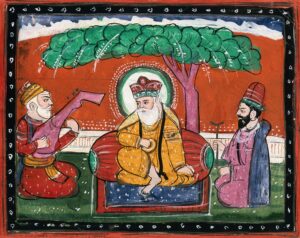Guru Tegh Bahadur Ji, the ninth Guru of the Sikhs, was born on April 1, 1621, in Amritsar, Punjab. He was the youngest son of Guru Hargobind Sahib Ji and Mata Nanaki Ji. Originally named Tyag Mal, he was later called Tegh Bahadur — meaning “Brave of the Sword” — after showing great courage in battle during his youth. Despite his martial skills, Guru Tegh Bahadur Ji was known for his deeply meditative and spiritual nature. He lived a quiet and humble life, devoted to Naam Simran (meditative remembrance of God), service, and solitude.
After the passing of Guru Har Krishan Ji, the eighth Guru, he left behind a cryptic message: “Baba Bakale,” indicating that the next Guru would be found in Bakala, a small town in Punjab. Many imposters emerged, each claiming the Guruship. However, a devoted Sikh named Makhan Shah Lubana discovered the true Guru — Tegh Bahadur Ji — when he miraculously identified the exact amount of offering Makhan Shah had vowed to give without being told. Thus, in 1664, Guru Tegh Bahadur Ji was formally anointed as the ninth Guru of the Sikhs.
Guru Tegh Bahadur Ji traveled extensively across Punjab, Haryana, Bihar, and Assam, spreading the teachings of Sikhism. He established new Sikh congregations (sangats) and laid the foundation of Anandpur Sahib in 1665, which would later become a spiritual and military center of Sikhism. His teachings emphasized inner detachment, fearlessness, compassion, and the oneness of God. He composed 116 hymns, which are included in the Guru Granth Sahib, focusing on human suffering, the value of contentment, and liberation through truth and devotion.
Guru Tegh Bahadur Ji’s most significant contribution came during a time of religious persecution under Mughal rule, especially under Emperor Aurangzeb, who sought to forcibly convert Hindus and other non-Muslims to Islam. A delegation of Kashmiri Pandits, led by Pandit Kirpa Ram, approached Guru Tegh Bahadur Ji in 1675, seeking his help to protect their right to practice their faith freely. Understanding the gravity of the situation, Guru Tegh Bahadur Ji decided to make the ultimate sacrifice — not for his own people, but to defend religious freedom for all, a universal principle deeply rooted in Sikh philosophy.
Before departing for Delhi, Guru Tegh Bahadur Ji proclaimed that his son, Gobind Rai (later Guru Gobind Singh Ji), should be appointed the tenth Guru. In Delhi, the Guru was arrested and imprisoned by Aurangzeb. He was offered the choice: accept Islam or face death. Guru Tegh Bahadur Ji refused to convert, asserting that no one should be forced to change their faith. To break his resolve, his companions were tortured and executed in front of him. Still, he remained unshaken.
On November 24, 1675, in Chandni Chowk, Delhi, Guru Tegh Bahadur Ji was publicly beheaded, becoming the first spiritual leader in history to sacrifice his life for the religious rights of another community. His martyrdom was not only a defining moment in Sikh history but a turning point in India’s religious and moral struggle against tyranny.
His body was secretly taken by a devoted Sikh, Lakhi Shah Vanjara, who burned down his own house to cremate the Guru’s body with dignity. The site is now the sacred Gurdwara Rakab Ganj Sahib. His severed head was carried with great risk to Anandpur Sahib by Bhai Jaita Ji, where Guru Gobind Singh Ji received it and honored his father’s supreme sacrifice.
Guru Tegh Bahadur Ji is remembered as “Hind di Chadar” — “The Shield of India” — for giving his life to uphold the freedom of religion, human dignity, and conscience. His legacy teaches that true spirituality demands not just personal enlightenment, but the courage to stand up for the oppressed, even at the cost of one’s life.















 Beyond its religious functions, the Gurdwara serves as a hub for community activities, bringing together the Sikh sangat for prayers, kirtan, and community events. The Gurudwara Baba Deep Singh affiliation underscores its dedication to upholding Sikh principles, contributing to the rich cultural tapestry of the Ganganagar area.
Beyond its religious functions, the Gurdwara serves as a hub for community activities, bringing together the Sikh sangat for prayers, kirtan, and community events. The Gurudwara Baba Deep Singh affiliation underscores its dedication to upholding Sikh principles, contributing to the rich cultural tapestry of the Ganganagar area.